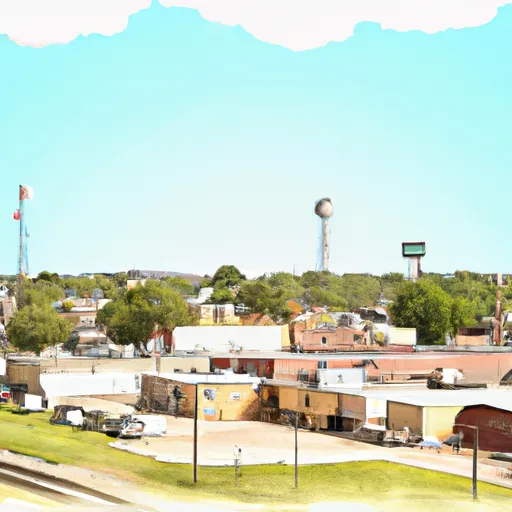-
 Snoflo Premium
Snoflo Premium
Get unlimited access to all our content
With no Ad interruptions! - Start Your Free Trial Login with existing account
Ingram
Eden Index
Climate
8.3
•
Recreation
2.5
•
Community
2.1
•
Safeguard
4.7/10

Located in Kerr County, Texas, Ingram is a small community that offers a pleasant climate and abundant outdoor recreation opportunities. The town experiences a humid subtropical climate, characterized by hot summers and mild winters. Summers are typically hot, with temperatures often reaching the mid to high 90s°F (mid 30s°C), while winters remain mild, with average temperatures in the 50s°F (10-15°C). The area receives moderate rainfall throughout the year, with May being the wettest month.
Ingram benefits from its proximity to the Guadalupe River, which flows through the town and provides numerous hydrology constituents. The river offers opportunities for swimming, fishing, kayaking, and canoeing. Visitors can also explore the nearby Ingram Lake, a popular spot for boating and water sports.
For outdoor enthusiasts, Ingram is surrounded by picturesque landscapes, including the Hill Country region, known for its rolling hills, scenic vistas, and diverse wildlife. The area offers various outdoor activities, such as hiking, camping, birdwatching, and wildlife photography. Nearby state parks, such as the Kerrville-Schreiner Park and the Lost Maples State Natural Area, provide additional opportunities for outdoor recreation.
Ingram, Texas, with its favorable climate and abundance of outdoor recreation options, is an appealing destination for nature lovers and those seeking to enjoy the beauty of the Texas Hill Country.
What is the Eden Index?
The Snoflo Eden Index serves as a comprehensive rating system for regions, evaluating their desirability through a holistic assessment of climate health, outdoor recreation opportunities, and natural disaster risk, acknowledging the profound impact of these factors on livability and well-being.
Climate Health Indicator (CHI): 8.3
Ingram receives approximately
770mm of rain per year,
with humidity levels near 89%
and air temperatures averaging around
18°C.
Ingram has a plant hardyness factor of
8, meaning
plants and agriculture in this region tend to thrive here all year round.
By considering the ideal temperature range, reliable water supplies, clean air, and stable seasonal rain or snowpacks, the Climate Health Indicator (CHI) underscores the significance of a healthy climate as the foundation for quality living.
A healthy climate is paramount for ensuring a high quality of life and livability in a region, fostering both physical well-being and environmental harmony. This can be characterized by ideal temperatures, reliable access to water supplies, clean air, and consistent seasonal rain or snowpacks.
Weather Forecast
Streamflow Conditions
Guadalupe
Area Rivers
Guadalupe
Snowpack Depths
Guadalupe
Reservoir Storage Capacity
Guadalupe
Groundwater Levels
Recreational Opportunity Index (ROI): 2.5
The Recreational Opportunity Index (ROI) recognizes the value of outdoor recreational options, such as parks, hiking trails, camping sites, and fishing spots, while acknowledging that climate plays a pivotal role in ensuring the comfort and consistency of these experiences.
Access to outdoor recreational opportunities, encompassing activities such as parks, hiking, camping, and fishing, is crucial for overall well-being, and the climate plays a pivotal role in enabling and enhancing these experiences, ensuring that individuals can engage in nature-based activities comfortably and consistently.
Camping Areas
| Campground | Campsites | Reservations | Toilets | Showers | Elevation |
|---|---|---|---|---|---|
| Brady Lake City Park | 80 | 1,755 ft | |||
| Fort Mason City Park | 30 | 1,494 ft | |||
| Richards City Park | 65 | 1,684 ft | |||
| Kerrville - Schreiner City Park | 140 | 1,598 ft |
Nearby Fishing
Nearby Ski Areas
Catastrophe Safeguard Index (CSI):
The Catastrophe Safeguard Index (CSI) recognizes that natural disaster risk, encompassing floods, fires, hurricanes, and tornadoes, can drastically affect safety and the overall appeal of an area.
The level of natural disaster risk in a region significantly affects safety and the overall livability, with climate change amplifying these risks by potentially increasing the frequency and intensity of events like floods, fires, hurricanes, and tornadoes, thereby posing substantial challenges to community resilience and well-being.
Community Resilience Indicator (CRI): 2.1
The Community Resilience Indicator (CRI) recognizes that education, healthcare, and socioeconomics are crucial to the well-being of a region. The CRI acknowledges the profound impact of these elements on residents' overall quality of life. By evaluating educational resources, healthcare accessibility, and economic inclusivity, the index captures the essential aspects that contribute to a thriving community, fostering resident satisfaction, equity, and social cohesion.

